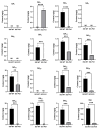Single-Base Methylome Analysis of Sweet Cherry (Prunus avium L.) on Dwarfing Rootstocks Reveals Epigenomic Differences Associated with Scion Dwarfing Conferred by Grafting
- PMID: 39456883
- PMCID: PMC11508414
- DOI: 10.3390/ijms252011100
Single-Base Methylome Analysis of Sweet Cherry (Prunus avium L.) on Dwarfing Rootstocks Reveals Epigenomic Differences Associated with Scion Dwarfing Conferred by Grafting
Abstract
Plant grafting using dwarfing rootstocks is one of the important cultivation measures in the sweet cherry (Prunus avium) industry. In this work, we aimed to explore the effects of the dwarfing rootstock "Pd1" (Prunus tomentosa) on sweet cherry 'Shuguang2' scions by performing morphological observations using the paraffin slice technique, detecting GA (gibberellin) and IAA (auxin) contents using UPLC-QTRAP-MS (ultra-performance liquid chromatography coupled with a hybrid triple quadrupole-linear ion trap mass spectrometer), and implementing integration analyses of the epigenome and transcriptome using whole-genome bisulfite sequencing and transcriptome sequencing. Anatomical analysis indicated that the cell division ability of the SAM (shoot apical meristem) in dwarfing plants was reduced. Pd1 rootstock significantly decreased the levels of GAs and IAA in sweet cherry scions. Methylome analysis showed that the sweet cherry genome presented 15.2~18.6%, 59.88~61.55%, 28.09~33.78%, and 2.99~5.28% methylation at total C, CG, CHG, and CHH sites, respectively. Shoot tips from dwarfing plants exhibited a hypermethylated pattern mostly due to increased CHH methylation, while leaves exhibited a hypomethylated pattern. According to GO (Gene Ontology) and KEGG (Kyoto Encyclopedia of Genes and Genomes) analysis, DMGs (differentially methylated genes) and DEGs (differentially expressed genes) were enriched in hormone-related GO terms and KEGG pathways. Global correlation analysis between methylation and transcription revealed that mCpG in the gene body region enhanced gene expression and mCHH in the region near the TSS (transcription start site) was positively correlated with gene expression. Next, we found some hormone-related genes and TFs with significant changes in methylation and transcription, including SAURs, ARF, GA2ox, ABS1, bZIP, MYB, and NAC. This study presents a methylome map of the sweet cherry genome, revealed widespread DNA methylation alterations in scions caused by dwarfing rootstock, and obtained abundant genes with methylation and transcription alterations that are potentially involved in rootstock-induced growth changes in sweet cherry scions. Our findings can lay a good basis for further epigenetic studies on sweet cherry dwarfing and provide valuable new insight into understanding rootstock-scion interactions.
Keywords: DNA methylation; Prunus tomentosa; rootstock–scion interactions; transcriptome; whole-genome bisulfite sequencing.
Conflict of interest statement
The authors declare no conflicts of interest.
Figures










Similar articles
-
Transfer of endogenous small RNAs between branches of scions and rootstocks in grafted sweet cherry trees.PLoS One. 2020 Jul 28;15(7):e0236376. doi: 10.1371/journal.pone.0236376. eCollection 2020. PLoS One. 2020. PMID: 32722723 Free PMC article.
-
Rootstock-induced dwarfing in cherries is caused by differential cessation of terminal meristem growth and is triggered by rootstock-specific gene regulation.Tree Physiol. 2009 Jul;29(7):927-36. doi: 10.1093/treephys/tpp027. Epub 2009 May 7. Tree Physiol. 2009. PMID: 19429629
-
Differential transcription pathways associated with rootstock-induced dwarfing in breadfruit (Artocarpus altilis) scions.BMC Plant Biol. 2021 Jun 5;21(1):261. doi: 10.1186/s12870-021-03013-6. BMC Plant Biol. 2021. PMID: 34090350 Free PMC article.
-
Dwarfism mechanism in Malus clonal rootstocks.Planta. 2024 Nov 6;260(6):133. doi: 10.1007/s00425-024-04561-5. Planta. 2024. PMID: 39503906 Review.
-
Rootstock Breeding of Stone Fruits Under Modern Cultivation Regime: Current Status and Perspectives.Plants (Basel). 2025 Apr 27;14(9):1320. doi: 10.3390/plants14091320. Plants (Basel). 2025. PMID: 40364348 Free PMC article. Review.
Cited by
-
Transcriptome analysis of heterografting on key medicinal compounds accumulation in Ziziphi Spinosae Semen.BMC Plant Biol. 2025 Aug 11;25(1):1061. doi: 10.1186/s12870-025-07104-6. BMC Plant Biol. 2025. PMID: 40784881 Free PMC article.
References
-
- World Flora Online (WFO) Prunus avium (L.) L. [(accessed on 28 July 2024)]. Available online: https://wfoplantlist.org/taxon/wfo-0001005630-2024-06?page=1.
MeSH terms
Substances
Grants and funding
LinkOut - more resources
Full Text Sources

